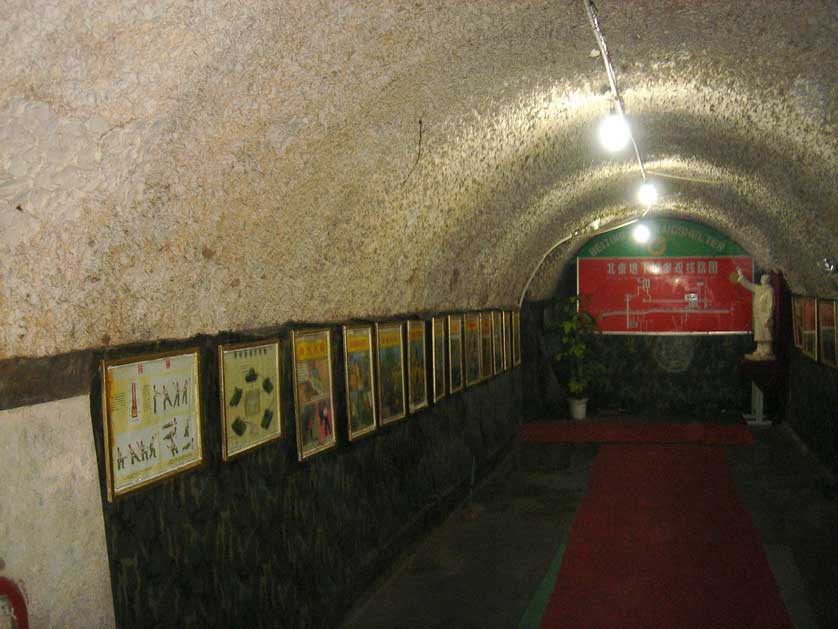Tunnels are conduits for transportation, defense, and escape that have long fascinated humans. Numerous secret and hidden tunnels have been discovered throughout history, revealing the inventiveness of their creators and, at times, their desperate circumstances. These hidden passages, frequently shrouded in mystery and intrigue, provide a glimpse into the past and demonstrate the inventiveness of their builders. Ten of the world’s most intriguing hidden tunnels are listed here.
1. The Catacombs of Paris

The Catacombs are a vast network of tunnels and chambers beneath the bustling city of Paris. Due to overcrowding in cemeteries, these tunnels, originally limestone quarries, were repurposed in the late 18th century to house the remains of over six million people. Over 200 miles long, the Catacombs provide a terrifying yet fascinating look at the city’s past and how its dead were managed.
2. The Derinkuyu Underground City

An ancient city that is subterranean and is carved into the soft volcanic rock in the Cappadocia region of Turkey. It is thought to have served as a haven during times of war or invasion, as it was discovered in the 1960s. An advanced comprehension of underground architecture can be seen in the city’s intricate networks of tunnels, ventilation shafts, and living quarters, which can hold up to 20,000 people.
3. The Cu Chi Passages

The Cu Chi Passages, situated close to Ho Chi Minh City in Vietnam, are a tremendous organization of underground sections utilized by the Viet Cong during the Vietnam War. There were living quarters, medical facilities, and storage areas in the over 250-kilometer tunnels. The Viet Cong’s guerrilla warfare strategy relied heavily on the Cu Chi Tunnels, which are still a significant historical site and popular tourist destination.
4. The Montreal’s RESO (La Ville Souterraine)

Is a vast network of underground complexes in Montreal, Canada. It is also known as La Ville Souterraine. Over 33 kilometers of tunnels connect shopping malls, hotels, and office buildings. The RESO is one of the largest underground complexes in the world and an essential component of Montreal’s urban infrastructure. It was constructed to provide a sheltered environment during the harsh winters.
5. The Beijing Underground City

The Beijing Underground City is a network of underground tunnels that date back to the Cold War and are located beneath Beijing, China. These tunnels were constructed in the 1960s and 1970s with the intention of serving as fallout shelters in the event of a nuclear attack. There are living quarters, hospitals, and storage areas within the 85-kilometer tunnels. They are still a reminder of the paranoia and preparedness of the Cold War, despite the fact that their original purpose has largely vanished.
6. Hidden or abandoned tunnels

The London Underground The London Underground is one of the world’s oldest and largest metro systems. These incorporate the popular “apparition stations, for example, Aldwych and Down Road, which were cut off and fixed during The Second Great War. Moreover, there are burrows from different deserted lines and development stages, each with its own set of experiences and secret.
7. The Unusual Network of Tunnels and Caves in Setenil de las Bodegas’

Rock Formations Setenil de las Bodegas is a town in southern Spain that is home to the Underground City. A fascinating mix of natural and man-made tunnels is created by the fact that many of the town’s homes and businesses are built into or beneath massive rock overhangs. The layout of the town is a reflection of how it has historically adapted to the natural landscape for protection and shelter.
8. The Vardzia Cavern Religious community

In the Republic of Georgia, the Vardzia Cavern Religious community is a staggering illustration of middle age cave engineering. Cut into the bluffs of the Erusheti Mountain, this religious community complex incorporates an organization of passages, chambers, and houses of prayer, with in excess of 600 rooms. It was built by Queen Tamar in the 12th century and served as a religious and defensive stronghold. It is still a marvel of ancient engineering and art.
9. The Newark Earthworks Tunnels

The Newark Earthworks are a group of ancient Native American earthworks in Ohio, USA, that include ceremonial structures and large geometric mounds. Underneath some of these earthworks are intricately concealed tunnel systems used for astronomical and perhaps ceremonial purposes. These tunnels’ precise purpose and significance are still the focus of research and debate.
10. The Svalbard Global Seed Vault Tunnels

The Svalbard Global Seed Vault is an advanced facility designed to store seeds from around the world as a safeguard against global catastrophes. It is situated on Norway’s Svalbard archipelago. There are a number of reinforced tunnels and storage rooms in the vault, which is carved into a mountain. The complex layout and remote location guarantee the world’s agricultural biodiversity’s preservation.
Conclusion
Hidden tunnels, whether they are ancient or modern, provide a fascinating look at human ingenuity and historical context. From underground urban communities and wartime asylums to puzzling cavern cloisters and modern storage spaces, these passages mirror the assorted necessities and savvy fixes of their developers. New discoveries may shed light on even more occluded passages as exploration and research continue, enhancing our comprehension of history and human endeavor.



GIPHY App Key not set. Please check settings